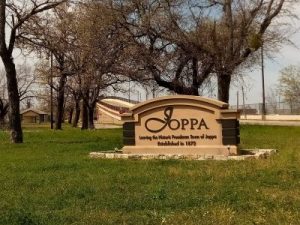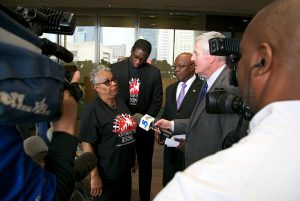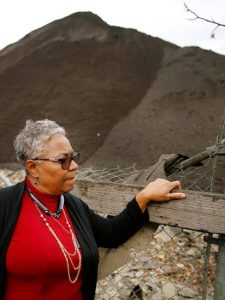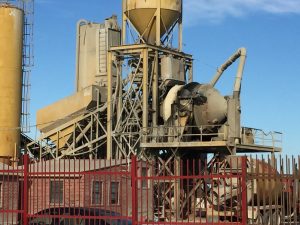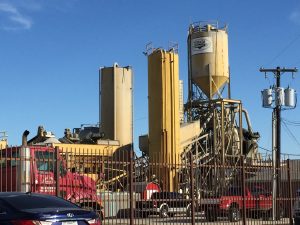Joppa
Robert Wood Johnson Foundation awards grant to Texas A&M and Downwinders at Risk for Joppa Environmental Health Project
Monies will fund unprecedented study of link between health and air pollution in Dallas Freedman’s Town; first effort of its kind in Texas
What’s believed to be the single largest environmental health research investment in a Texas neighborhood was awarded today by the Robert Wood Johnson Foundation to examine the links between human health and air pollution in the Joppa community of Dallas.
 Texas A&M and Downwinders at Risk’s Joppa Environmental Health Project was selected as one of only 16 national proposals funded by the Foundation’s Interdisciplinary Research Leaders grant. Between now and 2022, over $350,000 will be spent by Texas A&M scientists trying to understand the correlation between Particulate Matter air pollution and the health of the Freedman’s Town’s residents.
Texas A&M and Downwinders at Risk’s Joppa Environmental Health Project was selected as one of only 16 national proposals funded by the Foundation’s Interdisciplinary Research Leaders grant. Between now and 2022, over $350,000 will be spent by Texas A&M scientists trying to understand the correlation between Particulate Matter air pollution and the health of the Freedman’s Town’s residents.
Cecilia Wagonner, a member of the Joppa church that hosted a community meeting on air pollution monitoring last December, was enthusiastic about the news. “I want to know the truth and nothing but the truth about air quality in our historic neighborhood. This is definitely good news. Let environmental justice be served.”
Per capita, Joppa is the most polluted neighborhood in Dallas. On one side is the Trinity River. On the other three sides are an asphalt batch plant, Railroad switch yard, large asphalt shingle factory, a concrete batch plant, and Interstate highway. It’s directly downwind from the largest methane air p olluter in Dallas – the City’s McCommas Landfill methane energy recovery unit.
olluter in Dallas – the City’s McCommas Landfill methane energy recovery unit.
Since PM air pollution monitoring began there on August 31st as part of the new SharedAirDFW air monitoring network, Joppa’s PM levels have averaged significantly higher than other sites.
Two Texas A&M scientists based in College Station will lead the new Project. Dr. Natalie Johnson, is an A&M toxicologist specializing in the health effects of Particulate Matter air pollution, and Dr. Ping Ma, is an A&M behavioral and social science researcher who previously worked at Dallas Children’s Hospital specializing in health disparities and social determiners of health. Downwinders will assist with community canvassing and outreach efforts as well as provide technical support through its 11-Joppa based SharedAirDFW network monitors.
They’re now all charged with collecting evidence to discover whether Joppa has higher rates of PM air pollution and health problems than other communities, and understand how differences in daily levels of PM affect residents’ health.
“PM represents a significant ‘unseen’ health risk related to cardiovascular disease, chronic respiratory disease, including lung cancer and asthma, as well as effects on infant development and brain health,” said Johnson. “SharedAirDFW’s real-time pollution monitors will help make this threat ‘seen.”
Ping pointed out the study will be the first academic-community collaboration of its type in Texas. “Our findings will facilitate understanding of the air pollution risks Joppa residents face as well as generate community-based solutions to help create a new culture of environmental health in Joppa.”
Participa nts chosen for the IRL process also become students who receive training in the latest research methods and constant feedback from panels of experienced scientists and experts.
nts chosen for the IRL process also become students who receive training in the latest research methods and constant feedback from panels of experienced scientists and experts.
Grant monies will pay for staff time, graduate assistants, technology, travel, and community outreach over a three-year period.

The IRL grant is the first research project attracted by the SharedAirDFW regional air monitoring network that debuted in September, but Jim Schermbeck, Director of Downwinders, predicted it wouldn’t be the last. “This network makes all kinds of new comparisons and studies possible. In this case, residents and researchers are using it to document Joppa’s air pollution burdens and assist residents in relieving those burdens. That’s a first for Dallas, and Texas.”
From now until the end of the year the Project partners will be assembling their local contacts, refining their timeline and methodology, and getting ready to begin research in early 2021.
First Regional Air Monitoring Network “Meet and Greet” in Joppa Draws Packed House and Volunteers
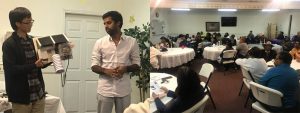
A new regional air quality network bringing 21st Century science to some of Dallas’ most polluted neighborhoods had it’s official coming out party on December 5th in the former Freedman’s community of Joppa.
A community meeting at New Zion Missionary Baptist Church sponsored by Downwinders at Risk in association with Paul Quinn College and Habitat for Humanity drew a standing room only crowd.
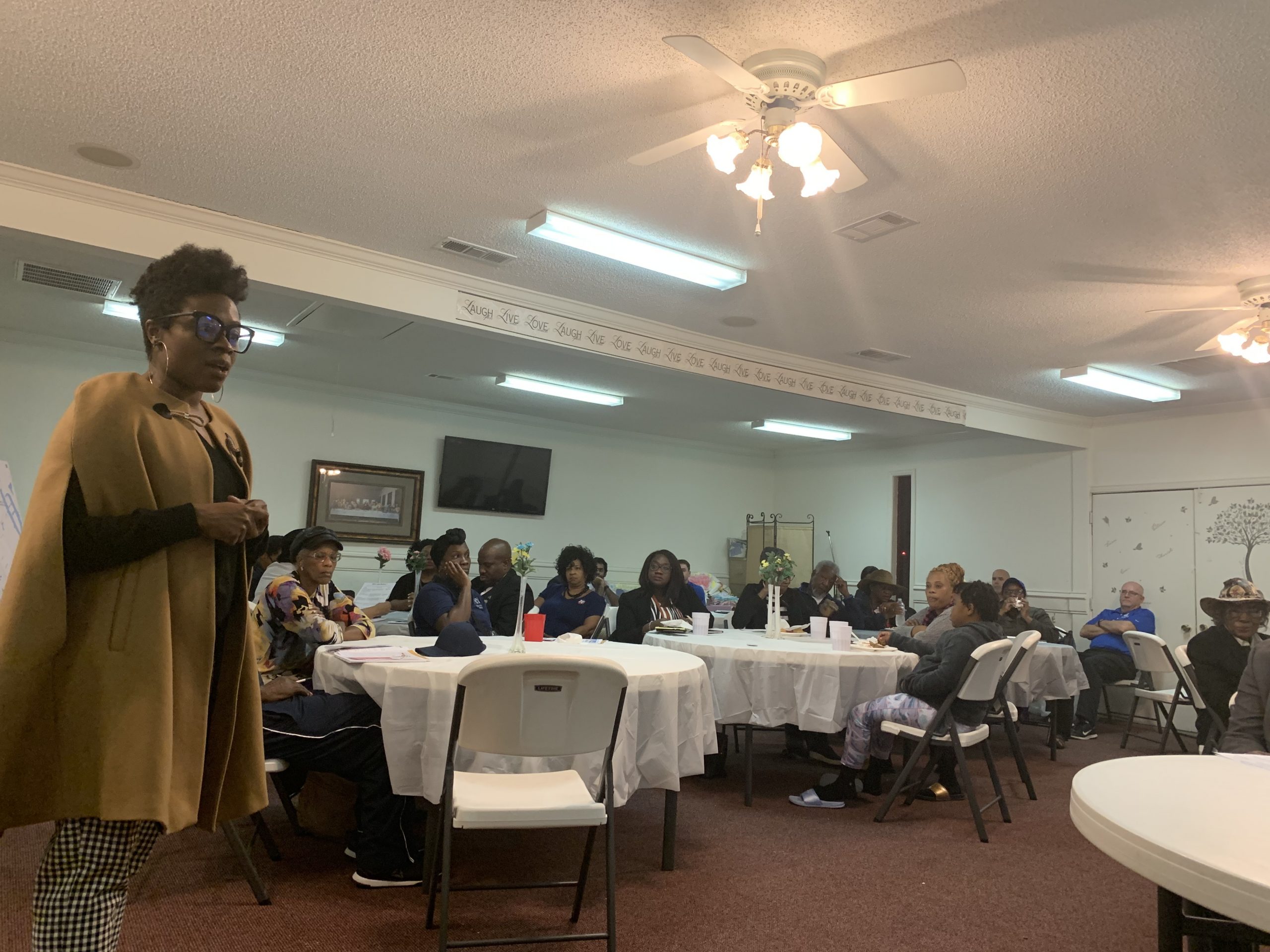 Food from Jason’s, door prizes, and the opportunity for a Parkland Hospital health screening made the meeting into a real community event.
Food from Jason’s, door prizes, and the opportunity for a Parkland Hospital health screening made the meeting into a real community event.
Residents got to see a monitor up close and hear a presentation by the University of Texas at Dallas graduate students building them for distribution over the next year. 11 of the monitors are due to be installed in Joppa, with another 11 installed in near-by Southern Dallas neighborhoods by Paul Quinn College. In total, over 100 are scheduled to be distributed from Plano to Fort Worth to Midlothian in the largest non-government network of its kind in Texas.
Joppa is surrounded by multiple sources of Particulate Matter air pollution, including a concrete batch plant, an asphalt batch plant, a Union Pacific railroad switch yard, Loop 12 and the Tamko asphalt shingle factory. Because of its compact size an relatively small population, it has the highest per capita air pollution burden in Dallas.
That’s why Downwinders chose to begin building its part of the network in Joppa. Thursday’s roll out was the first attempt to find hosts for the monitors among the neighborhood’s residents.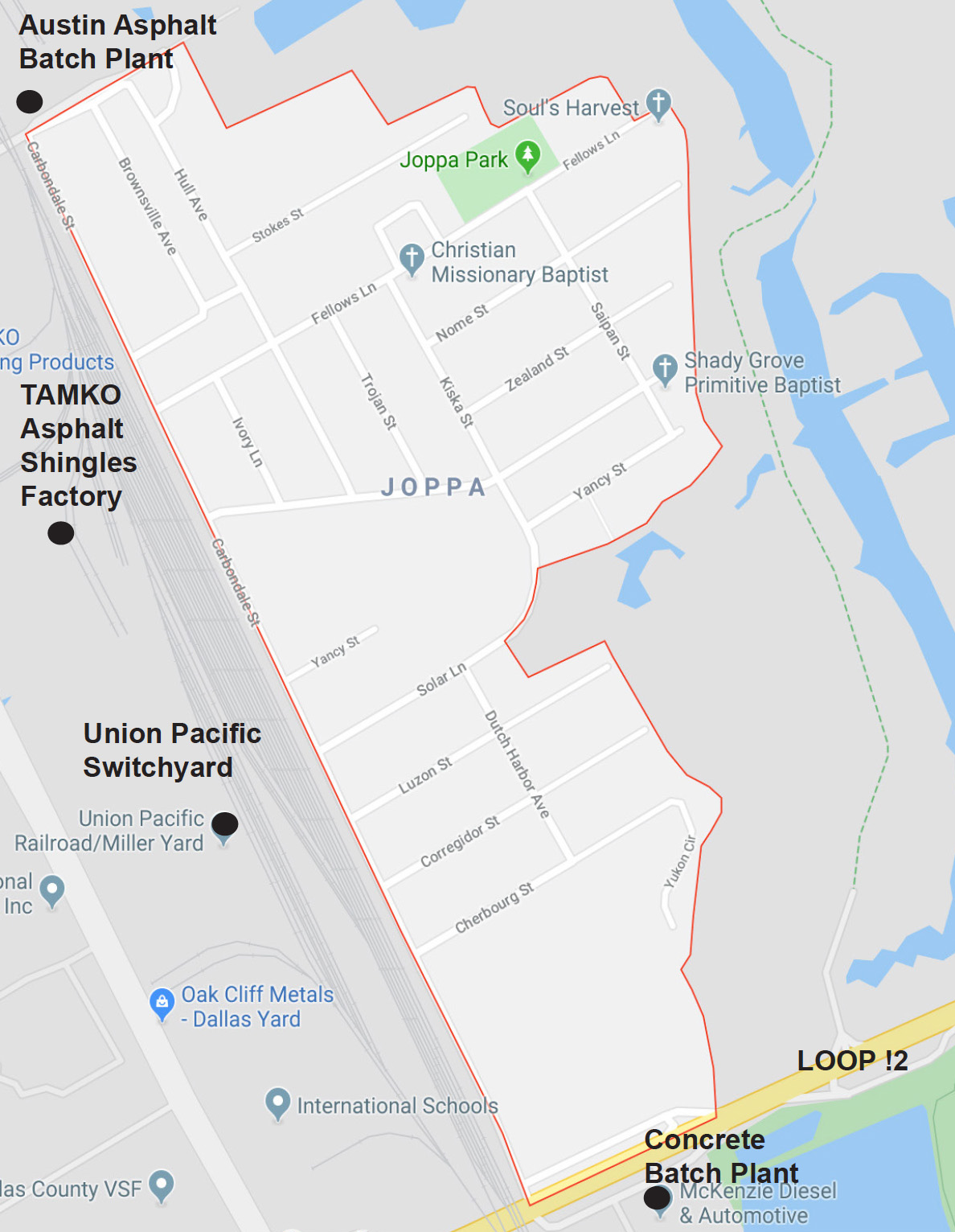
There were lots of questions and lots of enthusiasm. At least two Joppa residents didn’t need any more convincing and wanted to know how fast they could get a monitor at their house.
The answer is….soon. District 7 Council Member Adam Bazaldua is assisting the network in coordinating the electrical and internet connections we need for the “mothership” that carries the load for 10 smaller solar-powered and wireless sensors. A utility pole Downwinders bought from Oncor for that very purpose is only about 30 feet down the street road the New Zion Church where the meeting was taking place. All we need now are the connections.
Downwinders will be following up this meeting with door-to-door canvassing in Joppa and updates to everyone who signed-in. Meanwhile, we should be scheduling similar meetings in West Dallas and Midlothian after the first of the year.
After years of planning and preparation, we’re finally beginning to see the payoff of our vision. Thanks to all of our supporters for helping us achieve this first, but important milestone
Texas Misusing 17-Year Old Rural Air Pollution Model to Permit Inner-City Joppa Asphalt Plant
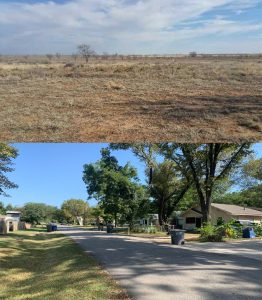
One of these is not like the other
What if you found out an industrial polluter was operating in your densely-populated neighborhood and the state told you not to worry because an obsolete computer model of the polluter’s releases 17 years ago and 500 miles away, in a desert, performed by the polluter themselves, said everything was OK?
That’s exactly the situation Joppa residents find themselves in as the Texas Commission on Environmental Quality (TCEQ) goes through the motions of renewing one of the permits of the many industrial polluters located in the community.
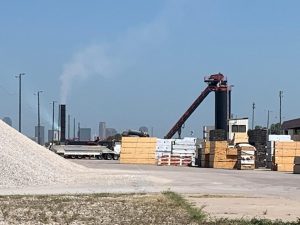 Austin Industries’ asphalt batch plant sits next to the Marietta Martin (TXI) concrete batch plant in Joppa, and both are in the Union Pacific switch yard and all of those are adjacent to the giant Tamko asphalt roofing factory.
Austin Industries’ asphalt batch plant sits next to the Marietta Martin (TXI) concrete batch plant in Joppa, and both are in the Union Pacific switch yard and all of those are adjacent to the giant Tamko asphalt roofing factory.
Austin has applied to the TCEQ for a renewal of its 10-year old air permit for its Joppa plant and gave notice last December. Legal Aid of NorthWest Texas requested a contested case hearing on behalf of the Joppa Freedman’s Town Association and Downwinders at Risk requested one on behalf of resident Jabrille McDuffie.
To absolutely no one’s surprise, TCEQ’s Executive Director recommended against such a hearing at the beginning of August in comments mailed out to all parities. He argued that contrary to the opponent’s claims there was sufficient evidence that Austin Industries permit in Joppa was following the law and was “protective of human health.” Previous “air quality analysis,” the Executive Director says, have concluded such already.
The entire basis of that “air quality analysis” is the computer air modeling performed by Austin Industries’ hired contractors and supposedly double-checked by the state…in 2002.
Just like any other computer model, it all depends on the variables: volume of air pollution, local meteorology, stack height, local “receptors” aka people or animals who live by or near the facility, and even local terrain. Winds do one thing to air pollution on the open plains and another in the middle of a city block.
Because of these variables, an Exxon refinery that wants to build a facility in Houston with the exact same design as is has in Arkansas still has to submit a separate computer model to account for the distinct surroundings in the new location. The one from Arkansas just won’t do for Houston.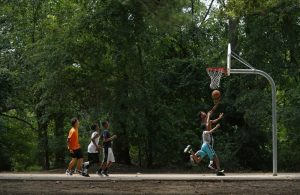
Or at least that’s the way things are supposed to work. But like so much else in Southern Dallas these days, things aren’t working the way they’re supposed to.
According to the TCEQ the Austin Asphalt facility is a portable asphalt batch plant operation. That means it wasn’t built specifically for its current Joppa site. It was moved there and it can be moved somewhere else.
In 2002 it first operated in Hockley County, a rural part of Northwest Texas near Lubbock some 400 miles west of Joppa. It moved to its current location in Joppa in 2008.
In 2002 the TCEQ let Austin Industries use what’s called a “SCREEN3” air model to determine if the air pollution from its asphalt batch plant’s was a threat to anyone in Hockley County. Again unsurprisingly, the firm hired by Austin Industries to do the computer modeling found it was “protective of human health.”
TCEQ says the Austin Industries’ asphalt plant has never been subject to any additional “impacts evaluation.” besides this 2002 review.
That means the only air modeling ever done for this Austin asphalt plant was while it was operating in rural Hockley County in 2002. There has been no air modeling of the plant since it came to Joppa in 2008.
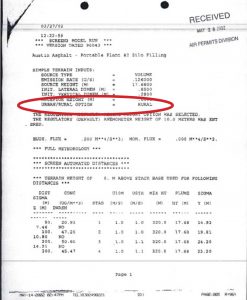
In 2002 the Austin plant was in West Texas and used a rural air model. In 2019 they’re still using for it for operation in Joppa.
Besides the most obvious and important difference in population density between unincorporated Hockley County near Lubbock and inner city Dallas, all of the variables in the 2002 modeling apply only to the Hockley County location. Meteorology, stack height, and surrounding terrain among them. In fact, the entire model was defaulted to a “rural” versus “urban” option in 2002. This renders the modeling scientifically useless in its current location in Joppa.
But that uselessness isn’t keeping the Executive Director of the Texas Commission on Environmental Quality from citing it to justify renewal of Austin’s air permit.
There’s also the matter of the age and limitations of the SCREEN3 model. In 2011 EPA replaced it with something called the “AERSCREEN” model. In doing so the agency called the old model “outdated“ and said “there are no valid reasons” to keep using SCREEN3.
And it’s not just the EPA. State environmental agencies, like the Arizona Department of Environmental Quality, have quit accepting SCREEN3 modeling.
Alex De Visscher, Associate Professor and Canada Research Chair in Air Quality and Pollution Control Engineering at the University of Calgary, writing in an 2013 text book entitled “Air Dispersion Modeling: Foundations and Applications,” said SCEEN3 is a “product of a previous generation of air dispersion modeling” and “is no longer a recommended model… it does not allow for multiple sources, and it does not include atmospheric chemistry or deposition.”
These exclusions are important. There are multiple sources of Particulate Matter 2.5 air pollution at Austin Industries’ plant in its Joppa location, including piles of raw material, and industrial combustion at the site. SCREEN 3 modeling didn’t and wouldn’t reflect these multiple sources of pollution. And of course when you’re talking about PM 2.5 pollution, as you are with an asphalt batch plant, the atmospheric chemistry and deposition, or fallout, is critical.
TCEQ’s own air modeling guidelines say so:
“Air dispersion models utilize dispersion coefficients to determine the rate of dispersion for a plume. Dispersion coefficients are influenced by factors such as land-use / land-cover (LULC), terrain, averaging period, and meteorological conditions. Evaluating the LULC within the modeling domain is an integral component to air dispersion modeling. The data obtained from a LULC analysis can be used to determine representative dispersion coefficients. The selection of representative dispersion coefficients may be as simple as selecting between rural or urban land-use types. For the ISC, ISC-PRIME, and SCREEN3 models, the dispersion coefficients are based on whether the area is predominately rural or urban. The classification of the land use in the vicinity of sources of air pollution is needed because dispersion rates differ between rural and urban areas.”
The TCEQ itself says it makes a fundamental difference whether the air model for a polluter is run for urban or rural terrain. Yet for over a decade TCEQ and Austin Asphalt have misused the results of a “rural” computer model to misleadingly assure inner-city Joppa residents that the company’s asphalt plant posed no harm.
What’s more, the modeling performed in 2002 only examined “asphalt vapors,” a made-up, vague pollutant category that can’t be monitored or measured. It didn’t examine Particulate Matter 2.5 pollution or specific Volatile Organic Compounds that make up those “vapors” and was therefore incomplete in the extreme.
So despite all the verbage the TCEQ’s Executive Director uses to tell Joppa residents th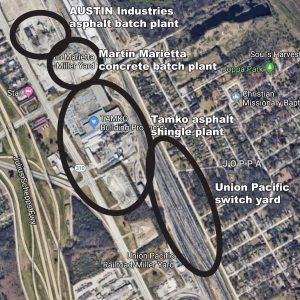 at past “air analysis” has shown Austin Industries’ plant to be protective of human health, in truth the only “analysis” ever done was performed 17 years ago in a sparsely-populated rural location 400 miles away from its current location, with what TCEQ admits are totally inaccurate modeling inputs by company consultants. It didn’t include all priority pollutants or even all sources of air pollution from the facility and the model used is now considered obsolete by EPA, modeling experts, and other state environmental agencies.
at past “air analysis” has shown Austin Industries’ plant to be protective of human health, in truth the only “analysis” ever done was performed 17 years ago in a sparsely-populated rural location 400 miles away from its current location, with what TCEQ admits are totally inaccurate modeling inputs by company consultants. It didn’t include all priority pollutants or even all sources of air pollution from the facility and the model used is now considered obsolete by EPA, modeling experts, and other state environmental agencies.
Joppa residents deserve better.
In its response to the Executive Director, Downwinders at Risk specifically requested TCEQ delay further regulatory action on this permit renewal until it can conduct a modern comprehensive air modeling impact analysis for Austin Asphalt’s current operation in Joppa that requires an evaluation of all on-site sources of pollution, including fugitive and mobile sources, on the Austin Asphalt site, off-site near-by sources of pollution within a three kilometer (1.86 mile) radius of Austin Asphalt’s facility, and representative monitored background concentrations obtained from local Joppa neighborhood monitoring as well as modeling of permitted maximums emission rates form all sources.
On September 11th the Texas Commission on Environmental Quality will take up the Austin Industries permit renewal at its headquarters in Austin. Both Legal Aid and Downwinders at Risk representatives will be present to answer any questions from the Commissioners but will not be allowed to make any statements. We’ll let you know the outcome.
One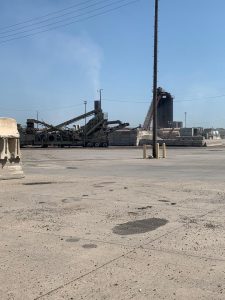 might reasonably ask why the City of Dallas itself isn’t fighting this permit renewal? After all in 2007, the city took on a string of proposed coal-fired power plants that it said would increase air pollution for Dallas. But to date that same city has never bothered to try and stop an industrial polluter from opening shop or renewing its permit in one of its most abused neighborhoods.
might reasonably ask why the City of Dallas itself isn’t fighting this permit renewal? After all in 2007, the city took on a string of proposed coal-fired power plants that it said would increase air pollution for Dallas. But to date that same city has never bothered to try and stop an industrial polluter from opening shop or renewing its permit in one of its most abused neighborhoods.
This dishonest use of a irrelevant model by the state’s discredited environmental agency shows why it’s imperative the City of Dallas – and all municipalities in Texas – change the way they do business and be proactive in addressing their environmental justice and environmental health issues in their own city limits.
Too often city representatives default to state or federal officials on the environment when they should be the first line of defense, not the last. City officials’ reliance on a failed state agency to perform its job as environmental protector is what caused Shingle Mountain. It’s what caused this situation in Joppa. To change that means changing both policies coming out of City Hall and current City Hall culture. Environmental Protection is a Do-It-Yourself proposition these days.
Southern Sector Rising Went Eyeball to Eyeball with Dallas City Hall over Shingle Mountain. Dallas City Hall Blinked.
After a year of excuses, a determined group of women and their supporters shamed the City into finally taking action to close down the worst environmental health and justice crisis in Dallas.
When the collapse came, it came quickly.
Halfway through their Wednesday March 20th news conference giving authorities an ultimatum to shut down “Shingle Mountain” or face protests and possible civil disobedience, members of the freshly minted Southern Sector Rising Campaign for Environmental Justice learned the City of Dallas was reversing course and moving to close Blue Star’s year-old asphalt hell.
Only a week before, the official party line from City Hall was that the self-described “recycler” had all the permits it needed. Staff said critics’ description of Blue Star’s operation as an illegal dumping ground was wrong. It had “a right to be there.”
Now, on Wednesday….well, now circumstances had changed. The political circumstances that is.
Now there was a new coalition of frustrated Southern Dallas residents and Old School Icons like Peter Johnson, Luis Sepulveda and John Fullenwider staging an emotionally-charged news conference with chants of “Shame on Dallas” ringing loudly up and down the corridors of City Hall. Now there was a publicly-leaked report with incriminating evidence of official wrongdoing. Now there were swarms of cameras and reporters hanging on the every word of a middle-aged, middle-class, horse-loving DART employee who had been ignored for such a long time.
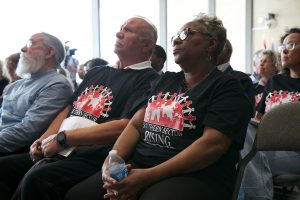
Three Generations of Dallas Environmental Justice Advocates: John Fullenwider, Luis Sepulveda and Marsha Jackson
Led by Marsha Jackson and her Choate Steet neighbors, Temeckia Durrough and Miriam Fields of the Joppa Freedman Town Association and Olinka Green from the Highland Hills Community Action Committee, with Stephanie Timko as media czarina, the Southern Sector Rising Campaign for Environmental Justice did more than just win a huge victory for an much-abused part of Dallas. It gave Southern Dallas residents a new model for effectively changing their circumstances.
An ad-hoc group that hadn’t even existed in February had the temerity to put City Hall on trial in its own lobby for Big D’s most spectacular municipal act of environmental racism in years. And it wasn’t even a fair fight.
An eye-opening state inspector’s report Downwinders sent to reporters a few days before the news conference officially documented permit violations and red flags too large to defend. Although Blue Star had promised the state in April 2018 it wouldn’t store more than 260 tons of waste at its site, it was already storing 60,000 tons in December. Blue Star was supposed to have a Fire Protection Plan. It didn’t. Blue Star was supposed to have adequate funds to close and clean up its site. It didn’t. Blue Star was supposed to randomly test incoming loads of shingles for asbestos. It didn’t.
This is how bad it was: Blue Star’s mocking of the law was too much even for Gregg Abbott’s Texas Commission on Environmental Quality. Or the City of Dallas.
So long before the last speaker spoke in the Flag Room, news came that the City had pulled the Certificate of Occupancy for the largest of the two Blue Star tracts, something it had previously said wasn’t possible. Then it announced it was taking the company to court the next day to get an emergency Temporary Restraining Order to close Blue Star down.
That City staff could so shamelessly pull off such a dramatic flip flop over a matter of a few hours is testimony to both the fury fueling the Campaign, and the overwhelming evidence that Blue Star and its government enablers had allowed a full-blown illegal dump to grow… and grow…and grow. The only thing missing from the turnaround was an apology and acknowledgement to the women that had forced City Hall’s hand.
In Thursday’s hearing on the Restraining Order, the City of Dallas cited a number of missing municipal and state permits it now said Blue Star needed, including a Special Use Permit, an air quality permit, and a permit for storage in the flood plain – none of which the City had demanded when Blue Star had opened for business a year earlier. Despite the lack of these permits the City was now saying were essential, it had kept telling reporters, Council Members, and residents alike that Blue Star was a legal business right up until the time of the news conference.
It wasn’t. Ever. But it took a group of frustrated Southern Dallas residents to expose that lie.
 Of course in the hearing itself the heretofore lack of official city concern about these lacking permits was perturbing in the extreme for the attorney representing Blue Star, who said City Hall had already signed-off on its operations.
Of course in the hearing itself the heretofore lack of official city concern about these lacking permits was perturbing in the extreme for the attorney representing Blue Star, who said City Hall had already signed-off on its operations.
“The City told my client there were NO air quality problems,“ he protested to the judge. That was undoubtedly a true statement. But that conclusion was rendered before a brigade of angry residents showed up at City Hall demanding Dallas enforce the law.
Now, presto-chango, the City was emerging out of its dilapidated telephone booth with its moldy Toxic Avenger costume on and finding plenty of air quality problems, albeit in a anecdotal, non-quantifiable, way.
Because despite being “very concerned” about air pollution from Blue Star, the City of Dallas never monitored air quality from the facility before it got to court. Neither did the state. Only Downwinders at Risk, plugging-in one of our own portable PM monitors on the top of Marsha Jackson’s window unit for days at a time, captured any credible scientific evidence of air pollution harms.
Those results were released at the March 20th news conference and showed levels of Particulate Matter pollution that UNT’s Dr. Tate Barrett concluded “poses a significant health risk to the residents.”
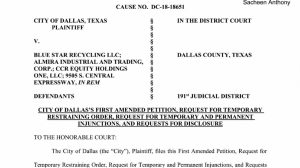
But in court, the City didn’t even mention those EPA-calibrated results.
For the first time in memory it was the regulators using only their senses to call for a crackdown – what they saw and heard and smelled at Blue Star’s site – and citizens showing up with Real Science.
Lacking any monitoring data of their own, Dallas city attorneys sounded like countless over-matched and overwhelmed residents from past TCEQ hearings, pleading with the judge to accept their word that the air pollution was so darn obvious…if not directly quantifiable because, well, no, we didn’t actually do any monitoring. We don’t know how to do that.
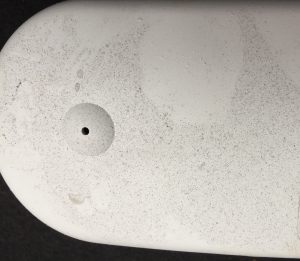
A layer of asphalt dust coated a Downwinders air quality monitor while it was recording levels of PM pollution at Marsha Jackson’s house in early March
This lack of any data to back up its air pollution claims was one of the most embarrassing parts of the hearing for the City. One wonders when James McQuire and his Office Of Environmental Quality & (Rockefeller) Sustainability’s stubborn refusal to buy its own air monitors will eventually cost the City (and its residents) in court.
But every time the City’s case looked in trouble, Blue Star’s attorney dug a deeper hole. He wanted the judge to know “shingles make really good fill” and that the spring-fed creek that ran through the company’s site was merely “a drainage ditch” and asking, after all judge, what is the true and right definition of “combustible” under Texas law?
Judge: “It means catch fire.”
Everyone but the Blue Star attorney chuckled.
After 45 minutes, Judge Gina Slaughter had heard enough and ruled in favor of the Restraining order. It took effect March 22nd and runs until Midnight on April 3rd.
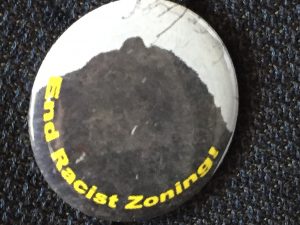 Before that happens, an 11 am Wednesday morning hearing will be held in the same courtroom to decide whether to extend the Temporary Order into a more permanent one. Word is that Blue Star was caught doing business during the last week when it wasn’t supposed to be on site at all. If true, it seems unlikely Blue Star will be granted a reprieve, despite the optimism displayed on the company’s website. “We fully expect to be open on Thursday April 4th, 2019″ it proclaims.
Before that happens, an 11 am Wednesday morning hearing will be held in the same courtroom to decide whether to extend the Temporary Order into a more permanent one. Word is that Blue Star was caught doing business during the last week when it wasn’t supposed to be on site at all. If true, it seems unlikely Blue Star will be granted a reprieve, despite the optimism displayed on the company’s website. “We fully expect to be open on Thursday April 4th, 2019″ it proclaims.
Not if Marsha Jackson, her friends in the Southern Sector Rising Campaign, and now their reluctant ally, The City of Dallas, get their way.
URGENT CALL TO ACTION FOR MARSHA JACKSON AND DALLAS’ SOUTHERN SECTOR
12 Noon, Wednesday March 20th
Dallas City Hall Flag Room 6th Floor
JOIN US FOR THE PUBLIC LAUNCH OF THE
SOUTHERN SECTOR RISING
CAMPAIGN FOR
ENVIRONMENTAL JUSTICE
Downwinders at Risk has joined with the the Joppa Freedman’s Association, Neighbors United/Vecino Unidos, the Highland Hills Community Action Committee, Sierra Club/BeyondCoal, Pax Christi Dallas, and other Dallas groups in initiating a campaign aimed at uniting residents who live along and south of the Trinity River, and their allies to say “enough is enough.”
The Southern Sector Rising Campaign for Environmental Justice seeks to end decades of racist zoning forcing industrial polluters into predominantly Black and Brown residential neighborhoods and more equitably distribute Dallas’ pollution burdens.
The Campaign’s First Target

SHINGLE MOUNTAIN
The most serious on-going environmental justice crisis in Dallas –
The Blue Star asphalt shingle sham recycling operation,
aka, “Shingle Mountain” aka “the Asphalt Alps.”
What makes this situation such a crisis?
Volume – thousands of tons of waste are accumulating with new loads arriving daily. The mountain is now4-5 stories tall.

Proximity – fine dust spewed and stored across the backyard fences of families with kids

Toxicity – Asphalt shingle waste is chock full of carcinogens
Help us apply more public pressure.
The Campaign’s First Action:

Public Launch @ DALLAS CITY HALL
WEDNESDAY MARCH 20th
12 NOON
FLAG ROOM 6th FLOOR
JOIN US AS WE PROPOSE A PRO-ACTIVE
DALLAS ENVIRONMENTAL JUSTICE AGENDA
1. The City of Dallas must immediately close the Blue Star Asphalt operation and begin to clean up the mess the company has created along the South Central corridor.
2. The City must include an equity provision in the City’s new Economic Development Policy prohibiting concentrations of polluters/pollution in the same neighborhoods.
3. The City must pass a moratorium on any new Industrial permits south of the Trinity River until that new industrial equity policy is in place.
4. The City must restore the City’s Environmental Health Commission to allow for a more resident-friendly process for hearing environmental nuisance and health problems.
5. The City must create a Joppa Environmental Preservation District prohibiting any new industrial permits in that historic Dallas Freedman’s community, phasing-out of existing industrial zoning there, and better protecting residents from pollution exposure.
March 20th’s launch at City Hall will begin with a video by local filmmaker Rick Baraff examining the personal toll Blue Star’s operations have had on the families who live around it. We’ll hear from Marsha Jackson, Biance Morales and members of her family as well as some very special guests.
It’s expected that at least one lawsuit, and maybe others, will be announced on March 20th on behalf of Ms. Jackson and the Morales’.
Campaign representatives will also be submitting language for specific ordinances the Dallas City Council to pass to implement the five campaign goals, announcing weekly pickets and a warning to the City that if Blue Star isn’t shut down by Earth Day, Monday April 22nd, we’ll be attempting to blockade new trucks of shingles from being dumped.
The Campaign’s First Protest

Picket Line at the front gate of Blue Star
12 noon to 2 pm, Saturday March 23rd
9527 S. CENTRAL EXPRESSWAY
VOTE WITH YOUR FEET TO HELP THIS NEIGHBORHOOD
IN ITS TIME OF CRISIS
This first protest at Blue Star will reflect Ms. Marsha Jackson’s deep ties to the Southern Dallas trail riding community. We’ll have a check-in tent with water, Rules of the Road and the latest information. We can supply some signs and help you create your own. The important thing is to show-up and support the effort to clean-up this horrible mess and the messes that decades of racist zoning have produced all over the Southern Sector.

Plan Commission Zoning Vote for Bird Lane Batch Plant: Round 2
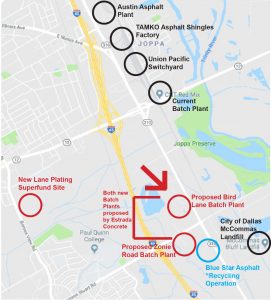
Dallas Plan Commission Hearing Scheduled
for Thursday January 17th, 1:30 pm
Dallas City Hall Rm 5ES
Speak Out Against
Systematic Environmental Racism
1) CLICK HERE TO SEND AN EMAIL TO
THE PLAN COMMISSION RIGHT NOW
Urge them to deny these permits…and consider a moratorium on ALL new industrial permits south
of the Trinity River “until the City can provide
a way to insure the same neighborhoods
are not always chosen to host them.”
2) SHOW-UP AT THE HEARING ON THE 17th
and speak against the zoning change
that Estrada Concrete is seeking.
Thanks in part to your emails, the Plan Commission delayed routine approval of the Bird Lane batch plant at its December 13th meeting and scheduled an individual hearing for Thursday, January 17th that could start as early as 1:30 pm at Dallas City Hall.
If you didn’t get a chance to send an email opposing the batch plant to the Plan Commission in December and want to do so you have that chance through our revised Featured Citizen Action “clickNsend” messaging. If you did send one in, send another.
This time, you can not only tell the Commission you oppose this specific permit…but ALL new industrial permits south of the Trinity River until the City of Dallas quits dumping all new polluters there.
We know the Bird Lane Batch Plant will be on the January Commission agenda but residents may be facing a twofer by then. The same company pursuing the Bird Lane site is also looking to put another new Batch Plant on Zonie Road right around the corner. After initially rejecting that effort because the paperwork wasn’t correct, it seems to be back on track up for Commission action as well – we just don’t know when yet.
All of this is just down the street from Blue Star Asphalt “Recycling” mess, aka Asphalt Mountain, current industry in Joppa, and close to the new Lane Plating Superfund site.
It seems certain that at the very least, the Plan Commission will decide on a Special Use Permit, or SUP, that Estrada Concrete needs to operate a concrete batch plant on the Bird Lane property for a minimum of three years..
Opposition is based both on the specific problems the batch plants would cause for neighbors, and the fact that this part of South Dallas already has a disproportional amount of polluting industries.
THANKS!
You generated over 60 letters of opposition to the Bird Lane Batch Plant
Zoning Vote for Bird Lane Batch Plant Pulled from December 13th Plan Commission Agenda
Individual Hearing Scheduled
Thursday January 17th, 1:30 pm
Dallas City Hall Rm 5ES
Speak Out Against Environmental Racism
The first of two Estrada Concrete batch plants proposed for right around the corner from Blue Star Asphalt Recycling and initially slated to be routinely approved as part of a group of more mundane zoning requests, is now scheduled for its own hearing and vote next month.
Thanks to neighborhood opposition, including, God Bless Them, Temeckia Dorrough and Marsha Jackson plus the Inclusive Communities Project, institutional opposition from near-by Paul Quinn College, and over 60 letters generated through the Downwinders’ Click N Send feature, the Plan Commission pulled the batch plant form its consent agenda on December 13th and scheduled a separate hearing and vote on the case for January 17th.
Had vigilant citizens not plugged-up the City Hall pipeline, this is a zoning change that would have passed easily with full staff support and without even a record vote by the Commission.
At stake is issuance of a Special Use Permit, or SUP, the owners need to operate a concrete batch plant on the Bird Lane property for a minimum of three years.
Still unknown is when the OTHER Estrada Concrete batch plant also gets the green light for a scheduled vote. It’s proposed for Zonie Road, immediately adjacent to and downwind of homes and a shingle’s throw from troubled Blue Star Asphalt Recycling. It’s possible both sites could be on the same January 17th Plan Commission agenda.
The Bird Lane site is already zoned Industrial Research (IR) while the Zone Road site is zoned Agricultural with a pending request to zone it Industrial Research as well. IR and Industrial Manufacturing, or IM zoning next to minority residential neighborhoods along the Trinity River has been the source of most local environmental justice battles.
Opposition is based both on the specific problems the batch plants would cause for neighbors, and the fact that this part of South Dallas already has a disproportional amount of polluting industries.
Come January we’ll be adjusting our Click N Send messaging to reflect the new Plan Commission hearing and vote date and let you know when you can have another big impact with your letters of opposition.
Discussion of both these proposed batch plants and the underlying zoning issue which keeps facilities like this coming to South Dallas will be on the agenda at the next “Let Joppa Breathe” Alliance meeting, scheduled for January 14th.
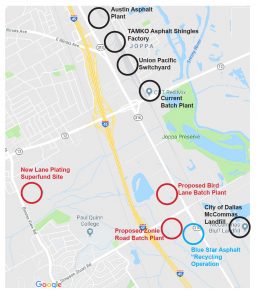
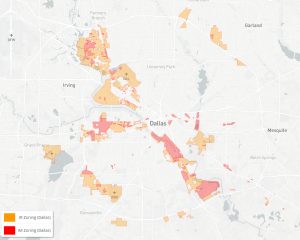
Dallas City Hall Stonewalls Open Records Requests for Mystery Clean Air Fund and Joppa Polluter
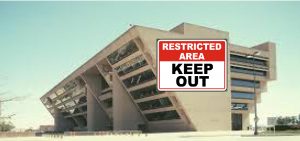
The question sounds like the lead-in to a joke, but it’s not: How many months does it take Dallas City Hall to respond to a simple Open Record request? Answer: we don’t know yet, we’re still waiting.
Back in July, you might remember we reported on the establishment of a regional clean air fund to fight coal plants a decade ago that still had over a half million dollars in it.
When we dug a little further, we got a response that the fund had been shut down and the money disbursed – despite the fact nobody could give us the details on how or why that happened, where the money went, and if any of it went to clean air work.
So we filed a Texas Open Records Act request to get any and all files on the fund. On July 16th. Governments have 10 days to respond and provide the files that aren’t attorney-client products. We have yet to get the paperwork we asked for from the City. What we have received is one after another email saying the response has been delayed…again. We’re now going on three months awaiting information for a fund that supposedly doesn’t even exist anymore. And this is after the city already received permission from the State Attorney General’s office to withhold certain files from us because they were “attorney product.” What is it about this fund and that half million dollars that the City of Dallas staff really don’t want their own residents to see?
Just as ridiculous is the city’s response to an Open Records Act request we filed to look at its files on TAMKO in August.
The huge asphalt shingles plant in Joppa had a long sting “upsets” and “accidents” between 2011 and 2015 that released over 7000 pounds of unaccounted for PM pollution. Those are TAMKO’s self-reported numbers and don’t even include fires when there was “100 Opacity” i.e., smoke. We know this because Downwinders was able to access the Texas Commission on Environmental Quality files on TAMKO way back in the summer. We put in the same request to the State that we submitted to the City of Dallas. Believe it or not, TCEQ was much more responsive and cooperative than the City of Dallas, who we’re still waiting on to release their files on the plant. Two months and counting and still no substantive response. Shouldn’t a resident be able to make an appointment, go down to City Hall and look at the public files on a well-known polluter? So far, the City of Dallas says no.
Dallas City Hall has a notorious reputation for mishandling, losing, or otherwise being non-responsive to Open Records requests. They aren’t know as “citizen-friendly.” But these two cases seem extreme because the delay is all out of proportion to the files being requested – for a fund that was shut down and a polluter in South Dallas. It certainly appears that staff is going out of its way not to hand over anything of import, no matter if its attorney work product or not. One can only guess why that is.
Joppa Becomes Citizen Science Case Study; Next Portable Monitor Training Session Oct 28th

Shannon Gribble and Cresanda Allen on a monitoring run in Joppa
You’re Invited to Train on the Same Portable Monitors & Get Access to Our Monitor Lending Library…For FREE
CITIZEN SCIENCE TRAINING SESSION
SUNDAY OCTOBER 28th
1-3 pm
GOODWORK CO-WORKING SPACE
1808 S. GOOD-LATIMER
Let us know you’re coming: RSVP downwindersatrisk@gmail.com
Downwinders is proud to announce that our precedent-setting use of portable PM monitors to help Joppa residents defeat two proposed batch plants earlier this year was selected by manufacturer Aeroqual as a case study showing how its new air pollution technology has made a positive difference in the world.
Joppa will join other examples from places like Tanzania, Iraq, India, and Peru on the Aeroqual website. It will be the only success story attributable to a citizens group as opposed to a government agency, university, or business.
“Timing is everything” is a cliche but in this case the banality is on point.

Aeroqual’s new 500 series hand held portable PM monitors had only become available in January of this year, at exactly the time Downwinders was looking for a device that was highly reliable but not prohibitively expensive. In offering the 500, New Zealand-based Aeroqual carved its own market niche and met our criteria like a glove – more reliable than the extremely cheap consumer sensors you can buy on Amazon and less expensive than similarly calibrated machines affordable only to universities, industry and government.
Because they were so new, we had to call Aeroqual in New Zealand to order them directly. We were their first US customers. Downwinders ordered two for deployment in our PM Pollution Prevention campaign. When they arrived in late February, they were the only ones being used between New Zealand and the US.
Since then, the company has made huge inroads into the US market, to the point of partnering with the EPA in Los Angles to establish a 100-monitor air network for Particulate Matter and smog pollution, and being considered for the monitor in the City of Dallas/Texas Nature Conservancy Breathe Easy study.
Downwinders’ original plan was to use the monitors to document PM levels along DART routes as research for our Green Streets bus electrification effort and set out for a couple of weeks doing nothing but measuring levels of PM inside and outside of buses.
We were still doing that when we got a call from the Joppa Freedman’s Township Association to request we turn our attention to their fight over two new batch plants.
Aeroqual’s portable machines provided the first, and so far only, air sampling in Joppa. They recorded significantly higher PM levels than the official EPA site some nine miles away. This was the same EPA site Dallas city staff was using to give Joppa the all-clear. The fact that the Aeroqual monitors came factory-calibrated out of the box and were supervised in their use by a local atmospheric scientist enhanced their credibility.
Their results were widely publicized only days before the City Council vote and combined with opposition on the ground, contributed to the council vote against the batch plant permits. It was the first time in local history, and we’re pretty sure in Texas or even the country, that this new technology became a tool for citizens in a successful permitting battle. And that’s why we’re ending up as the first citizens group case study for Aeroqual.
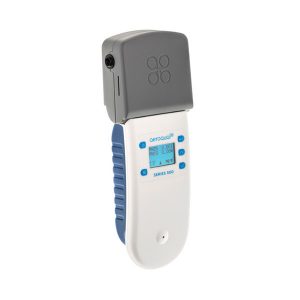
NOW IT’S YOUR TURN: MAKE HISTORY
CITIZEN SCIENCE TRAINING SESSION
SUNDAY OCTOBER 28th 1-3 pm
GOODWORK CO-WORKING SPACE
1808 S. GOOD-LATIMER
Let us know you’re coming: RSVP downwindersatrisk@gmail.com
This training session is a chance to become familiar with this new technology and work your way toward being able to check out these portable monitors on your own. No previous experience required. No math or engineering degrees necessary. If you can push buttons and read numbers, you can do this. It only takes two hours.

Along with first-timers, graduates from our first classes of Apprentice Citizen Scientists are invited back to take a field trip with our PM Committee and step-up to “Researcher” status. After one more outing, they’ll be given permission to check out the monitors for their own purposes or to help with our projects.
We’re entering a new era of Do-It-Yourself Environmental Protection. Learn how you can join it.
The Long March To Environmental Justice Begins with First “Let Joppa Breathe Alliance” Meeting

Council Member Kevin Felder welcomes participants to the Let Joppa Breathe meeting at GoodWork last Monday night.
Approximately 20 representatives from advocacy groups, non-profits, and neighborhoods gathered last Monday evening at GoodWork for the very first meeting of the “Let Joppa Breathe Alliance.” It was the first step in organizing a city wide effort to reverse over a century of racist zoning and land use planning in Dallas’ oldest Freedman’s community.
Besides Downwinders, there were members of Joppa Freeman’s Township Assocition, the South Central Civic League, the Inclusive Communities Project, Paul Quinn College, the NAACP, North West Texas Legal Aid, and Mia Carmen Theater company. As impressive as the breadth of support was, it was also the first time in memory that whites constituted a tiny fraction of attendance at a citywide Dallas environmental strategy meeting.
Rage Almighty, the spoken word artist who MC’d the May 22nd Joppa benefit was back to facilitate. District 7 Council  Member Kevin Felder was also back to welcome participants and encourage the building of the broadest possible coalition to win victories.
Member Kevin Felder was also back to welcome participants and encourage the building of the broadest possible coalition to win victories.
On the agenda were updates from the community, including photographic evidence presented by JFTA’s Temeckia Derrough of continued dust and diesel pollution problems from the existing Martin Marietta batch plant operation. There are continuing rumors about the company coming back to request a second chance at permitting the two proposed batch plants that were denied by the city council in March.
There was also discussion about how the group can estimate the emissions from all the short-haul diesel locomotives going back and forth in the Union Pacific switch yard that runs the length of the entire community. Usually the engines that end up in a switch yard are already old and in need of maintenance – yard duty is seen a step away from retiring the locomotive. Their exhaust contains a very toxic form of PM called Carbon Black that’s more carcinogenic than your average PM pollution. Electrification of these locomotives would eliminate a significant source of PM pollution in Joppa.
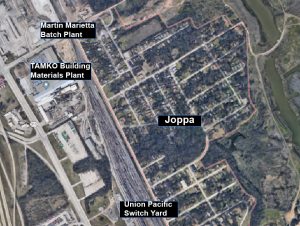 Misti O’Quinn with Downwinders reported that the group and UTD were very close to reaching a deal to place the first air monitor in Joppa, with a location to be announced soon. Another ten have been ordered and will probably be ready to be installed by November. The search is on for locations, with emphasis on getting front line readings close to batch plant, switch yard and the TAMKO shingles plant.
Misti O’Quinn with Downwinders reported that the group and UTD were very close to reaching a deal to place the first air monitor in Joppa, with a location to be announced soon. Another ten have been ordered and will probably be ready to be installed by November. The search is on for locations, with emphasis on getting front line readings close to batch plant, switch yard and the TAMKO shingles plant.
Plans are in the works to have a neighborhood enforcement workshop that includes the staff from City of Dallas Office of Environmental Quality, North West Texas Legal Aid attorneys and others advising residents how to be more effective in making complaints that can stick and lead to changes. Tentative scheduling has it penciled in for a date in later October or early November.
Participants scheduled the next Let Joppa Breathe Alliance meeting for 6 to 8 pm on Tuesday, October 23rd at GoodWork Co-Working space, 1808 S. Good Latimer. All groups are invited to send a representative. This isn’t just an environmental issue. It’s a civil rights issue. The more groups we represent, the faster we can get needed change.

